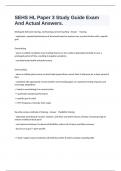SEHS HL Paper 3 Study Guide Exam
And Actual Answers.
Distinguish between training, overtraining and overreaching - Answer Training
- systematic, repeated performance of structured exercise sessions over a period of time with a specific
goal
Overtraining
- when an athlete completes more training than he or she is able to physically/mentally to over a
prolonged period of time, resulting in negative symptoms
- can deteriorate health and performance
Overreaching
- when an athlete places stress on their body beyond their current limit of tolerance for a short period of
time
- combined with appropriate recovery before overreaching again can maximize training response and
encourage adaptations
>> leads to overtraining if no recovery time
>> systematic repeated performance
>> specific goal in mind
>> FITT (frequency, intensity, time, type)
Describe various methods of training - Answer Flexibility Training
- systematic stretching of muscles, tendons, and other connective tissues of body, increasing range of
motion of affected body parts
- can improve technique, fix abnormal flexibility, reduce risk of injury and allow recovery
- focuses on a goal > sport-specific
>> Static- target muscle stretched until mild discomfort & held in position (standing still)
,>> Active- muscle held statically in stretch position via contraction of opposing muscle (stretch quad by
contracting hamstrings)
>> Dynamic- target muscle moved with control using repeated dynamic movements through full ROM
with gradually increasing reach/speed (stretch hip by kicking back and forth, increasing each time)
>> Ballistic- repeated bouncing motion at point of peak stretch to attempt to force tissue beyond normal
ROM
>> Proprioceptive neuromuscular facilitation (PNF)- static stretch followed by isometric contraction at
target for 10 seconds; brief relaxation of the muscle and another static stretch further than initial
(hamstring stretch)
Strength and Resistance Training
- application of resistance against muscle contractions to increase strength, size, or power of skeletal
muscle or alter its metabolic profile; uses gravity, body weight, bands, fixed weights, and free weights
- can change musculoskeletal system depending on method (increased bone, muscle, tendon, and
ligament strength, improved joint function, reduced risk of injury, increased bone density, & improved
neuromuscular/cardio function)
- specific goal to athlete
- uses periodization
Circuit Training
- combines S&R training exercises with aerobic/cardiovascular exercises to achieve overall increase in
conditioning
- sequence of exercises for a set amount of time/repetitions followed by short recovery before moving
onto next exercise
- completion of all exercises = circu
Discuss possible indicators of overtraining - Answer the PROCESS that leads to overtraining syndrome
- training that exceeds athlete's toleration and does not have sufficient recovery (fail to adapt to training,
can involve outside factors)
- to prevent OTS, need to change routine to prevent overtraining and stop "going hard" everyday > do
something not as physically challenging
,Symptoms...
- sudden, unexplainable and persistent performance decrement
- resting heart rate (increase = illness or reduced exercise tolerance)
- chronic muscle soreness (not DOMS, produced by increased levels of cytokines > cascade effect
producing more cytokines > systemic tissue inflammation; susceptible to athlete's perception)
- reduced immune function
- sleep disturbance
- fatigue (altered brain chemistry)
- decreased appetite
Discuss how periodization should be organized to optimize performance and avoid overtraining or injury
- Answer Periodization is structured, organized approach to training revolving around completion of
certain "phases" of training within a given time frame, with aim of ensuring athlete in peak physical
condition for important events of their sport
- depends on specific sport, performance level, experience, performance potential and sporting calendar
Transition (post-season)
- goal: rest and relax physically and mentally while maintaining acceptable level of physical fitness
- 3 to 4 weeks
- no exercise unhealthy (detraining, lack of conditioning, placing strains on body on next cycle)
Preparation (pre-season)
- goal: prepare athlete with physical, psychological, technical & tactical tools necessary to maximize
performance in competitive phase
- 3 to 6 months executed appropriately
>> General preparatory phase: developing athlete's basic fitness/physical conditioning to allow greater
toleration of greater volume/intensity as phase progresses and development of technical and tactical
skills
>> Specific preparatory phase: focus to prepare athlete for competitive season with more specific
objectives to skills and technical requirements of athlete's sport
, Competition
- goal: maintain general physical condition, continue improving sport-specfic skills and technique, perfect
tactical approach to competition and gain experience
- reduces training volume
- breaks down and improves sport-specific skills
- not appropriate to make large gains in fitness
Microcycle
- WEEKLY training program
- training and recovery within a week with a specific goal, which contributes to overall goal of training
phase
Mesocycle
- block of training with several macrocycles to achieve specific goal to reach overall phase goal
Macrocycle
- training program for an entire YEAR
- contains 3 main phases, micro and mesocyles
- start with macrocycle and work b
Explain the relationship between cellular metabolism and the production of heat in the human body -
Answer Energy liberation, ATP re-synthesis and heat production ??
Heat is a byproduct of metabolism: to get rid of the heat, it must be transferred away from the core, and
be redistributed to the skin, where it can be lost to the environment.
When metabolism increases, more heat is produced
When metabolism decreases, less heat is produced




